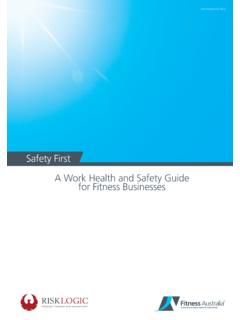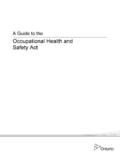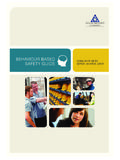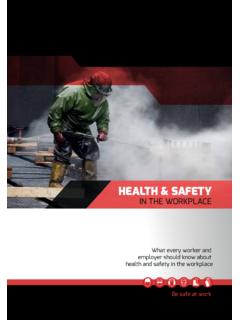Transcription of Health and safety made simple
1 Health and safety Executive Health and safety made simple The basics for your business Introduction This guide is for employers and those who want some basic information on what they must do to make sure their businesses comply with Health and safety law. Managing Health and safety doesn't have to be complicated, costly or time- consuming. In fact it's easier than you think. If you have taken reasonable steps to prevent accidents or harm to your employees (and the injury or illness was caused after 1 October 2013), you shouldn't have to pay compensation. For many businesses, all that's required is a basic series of practical tasks that This is a web-friendly version protect people from harm and at the same time protect the future success and the of leaflet INDG449(rev1), growth of your business. This guide will take you through the steps and help you published 08/14 make sure you have done what you need to and no more.
2 In general, Health and safety laws apply to all businesses. As an employer, or a self-employed person, you are responsible for Health and safety in your business. Health and safety laws are there to protect you, your employees and the public from workplace dangers. The approach you take should be proportionate to the size of your business and the nature of your business activity. For most small, low-risk businesses the steps you need to take are straightforward. If you have fewer than five employees you don't have to write down your risk assessment or your Health and safety policy. How the guide can help you This guide makes life easier for you by providing the basic information on what you need to do in one place. It will help you get started in managing Health and safety in your business. Following this guidance is normally enough to comply with the law.
3 You are free to take other action, except where the guidance says you must do something specific. We've introduced the H&S ABC. logo onto guidance and tools For some work activities there may be extra things you need to do. Throughout the to show small and medium- guide there are web links that will take you to further information on the HSE website. sized businesses just how straightforward Health and safety can be. So when they Stop check! see the logo, they know that This guide includes Stop check!' boxes they tell you when you may need to take it's designed specifically with extra steps and provide signposts to more detailed guidance and industry-specific them in mind. advice. Page 1 of 12. Health and safety Executive Decide who will help you with your duties As an employer, you must appoint someone competent to help you meet your Health and safety duties.
4 A competent person is someone with the necessary skills, knowledge and experience to manage Health and safety . If you run a low-risk business, Health and safety is something you can manage without needing to buy in expert help. Here you could appoint yourself as a competent person or one or more of your workers. However, if you are not confident of your ability to manage all Health and safety in-house, or if you are a higher-risk business, you may need some external help or advice. Deciding what help you need is very important. Unless you are clear about what you want, you probably won't get the help you need. Use the web links below to get more information and to help you ask the right questions: Get competent advice ( ). HSE leaflet: Getting specialist help with Health and safety ( ). Write a Health and safety policy for your business Describing how you will manage Health and safety in your business will let your staff and others know about your commitment to Health and safety .
5 This will be your Health and safety policy. It should clearly say who does what, when and how. If you have fewer than five employees you don't have to write down your Health and safety policy. The policy does not need to be complicated or time-consuming. To help you, we have created a template that you can download and complete. The template also includes a section for your risk assessment so that you can record everything in one document. Use the copy at the back of this guide or you can find it online ( ). We also provide an example Health and safety policy to give you an idea of what to include when writing your own ( ). A policy will only be effective if you and your staff follow it and review it regularly. Health and safety made simple : The basics for your business Page 2 of 12. Health and safety Executive Control the risks in your business You must control the Health and safety risks in your workplace.
6 To do this you need to think about what, in your business, might cause harm to people and decide whether you are taking reasonable steps to prevent that harm. This is known as a risk assessment. You are probably already taking steps to protect your employees, but your risk assessment will tell you whether you have covered all you need to. A risk assessment is not about creating huge amounts of paperwork, but rather about identifying sensible measures to control the risks in your workplace. You should record your significant findings, but there is no need to record everyday risks. Keep it simple and focus on controls. If you have fewer than five employees you don't have to write anything down. The law does not expect you to remove all risks, but to protect people by putting in place measures to control those risks, so far as reasonably practicable.
7 Your risk assessment need only include what you could reasonably be expected to know . you are not expected to anticipate unforeseeable risks. For most low-risk businesses controlling risks is straightforward. HSE has created tools to help you. We have online risk assessment tools to help businesses working in offices and shops complete their risk assessment quickly ( ). We also have a selection of example risk assessments ( casestudies). They show you what a completed risk assessment might look like for your type of business. You can use these as a guide when doing your own. An easy way to record your findings is to use the risk assessment template. This template also includes a section for your Health and safety policy so you can record everything in one place. You can find it online ( ) or use the copy at the back of this guide .
8 How do I assess the risks in my workplace? A good starting point is to walk around your workplace and look for any hazards (things that may cause harm). Then think about the risk, which is the chance, high or low, of somebody being harmed by a hazard, and how serious the harm could be. Think about how accidents could happen and who might be harmed. Ask your employees what they think the hazards are, as they may notice things that are not obvious to you and may have some good ideas on how to control the risks. Concentrate on the real risks those that are most likely to cause harm. Consider the measures you are already taking to control the risks and ask if you have covered all you need to do. Health and safety made simple : The basics for your business Page 3 of 12. Health and safety Executive Once you have identified the risks and what you need to do to control them, you should put the appropriate measures in place.
9 Then record your significant findings. Any paperwork you produce should help you to manage the risks in your business and tell people what they need to know. For most people this does not need to be a big exercise just note the main points down about the significant risks and what you concluded. If you have fewer than five employees you don't have to write anything down. You can get more help and ideas on ways to control your risks by going to the risk management pages on our website ( ). Few workplaces stay the same and sooner or later you will bring in new equipment, substances or procedures that could lead to new hazards. It makes sense to review your risk assessment on a regular basis. If anything significant changes, check your risk assessment and update it. Stop check! Don't forget to consider everyone who could be harmed Some workers may have particular requirements.
10 You can get more help on our diversity pages ( ). Think about homeworkers, and people who might not be in the workplace all the time, such as visitors, contractors and maintenance workers. Take members of the public into account, if they could be hurt by your work activities. If you share a workplace with another business, you will need to consider how your work affects others and how their work affects you and your staff. Talk to each other and work together to make sure controls are in place. High-risk activity For some activities that are recognised to carry high risks there are particular control measures beyond those set out in this guide that are required by law. The HSE website ( ) has information on specific activities and industries to help you decide what you need to do about the risks. A few examples are working at height, working with chemicals or other dangerous substances, working with machinery, gas, electricity and asbestos or working within explosive atmospheres.


















